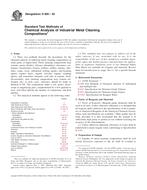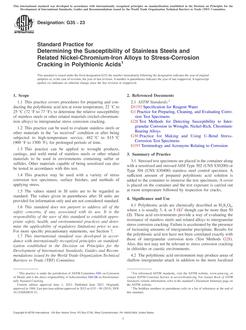
ASTM D800-05
1.1 These test methods describe the procedures for the chemical analysis of industrial metal cleaning compositions in solid, paste, or liquid form. These cleaning compositions may contain caustic alkalies, silicates, phosphates, chromates, carbonates, bicarbonates, borates, sulfates, sulfites, nitrates, chlorides, soaps, rosin, sulfonated wetting agents, anti-foaming agents, organic bases, organic solvents, organic coupling agents, and sometimes inorganic acid salts or organic acids. Occasionally, such cleaning compositions may contain sulfonated oils; in such cases, reference should be made to Method D 500. The examination under a low power microscope or magnifying glass, supplemented by a few qualitative tests, will often indicate the number of components and their identity.
1.2 The analytical methods appear in the following order:
| Section | |
| Preparation of Sample | 4 |
| Total Alkalinity as Na | 5-8 |
| Total Fatty Acids (and Rosin) | 9 and 10 |
| Na | 11 and 12 |
| Anhydrous Soap | 13 |
| -Rosin (McNicoll Test Method): | |
| Qualitative | 14 and 15 |
| Quantitative | 16-19 |
| Total Silica Calculated as SiO2 | 20-23 |
| Phosphates: | |
| Qualitative | 24 and 25 |
| Quantitative | 26-18 |
| Combined Sodium and Potassium Oxides | 34-37 |
| Chlorides | 38-40 |
| Sulfates | 41-43 |
| Water, Distillation Test Method | 44-47 |
| Carbon Dioxide by Evolution-Absorption Test Method | 48-52 |
| Loss at 105C | 53 and 54 |
| Total Matter Insoluble in Alcohol | 55-57 |
| Free Alkali | 58-60 |
| Synthetic Detergent or Wetting Agent | 61 and 62 |
| Volatile Hydrocarbons | 63-67 |
| Loss on Ignition | 68 and 69 |
| Report | 70 and 71 |
1.3This standard does not purport to address all of the safety concerns, if any, associated with its use. It is the responsibility of the user of this standard to establish appropriate safety and health practices and determine the applicability of regulatory limitations prior to use.
Product Details
- Published:
- 05/01/2005
- Number of Pages:
- 12
- File Size:
- 1 file , 160 KB
- Redline File Size:
- 2 files , 300 KB

